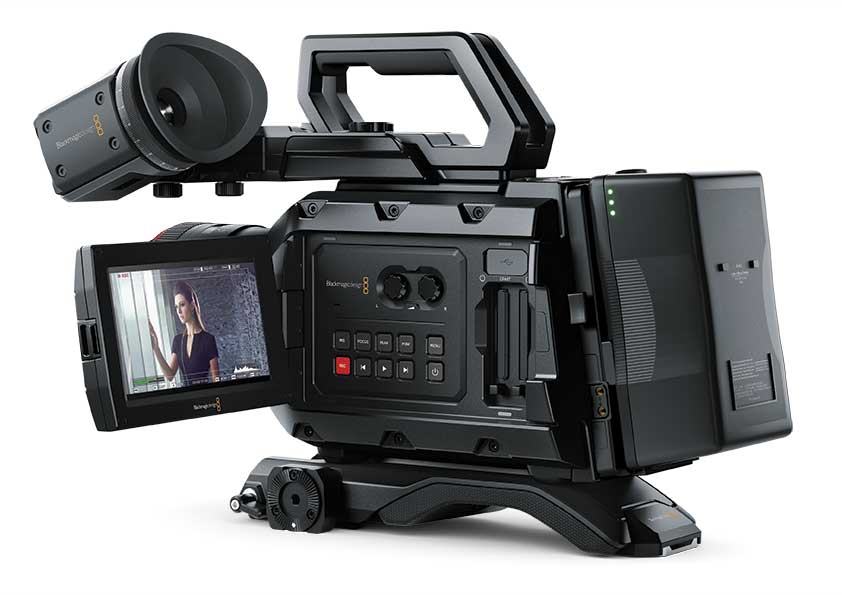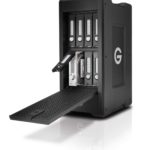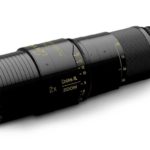
REVIEW: URSA Mini Software v4
Posted on Jan 3, 2017
 Blackmagic advertises the URSA Mini as the lightest S35 in the world.
Blackmagic advertises the URSA Mini as the lightest S35 in the world.
It looks like a video camera and you don’t have to be a weightlifter to carry it, but with its new software, can the URSA Mini beat the rest of the field? Words from Adam Garstone.
The ‘big’ URSA is big – astonishingly big. It’s probably one of the heaviest non-film cameras I’ve ever come across. It’s also weird – in a good way. It’s designed for a two- or three-person camera crew, and the thought of putting it on your shoulder would terrify Geoff Capes (remember him?).
The URSA Mini has been around – kinda – for some time now, and Blackmagic advertises it as the lightest S35 camera in the world. The greatest thing about the URSA Mini has always been its conventionality. Whereas the rest of Blackmagic’s cameras are quirky, the Mini looks like a video camera. With some options fitted, it sits on your shoulder, has an eye-level viewfinder, a handle on the top and a battery on the back.
v4 is a major redesign – and a very welcome one. From the moment you power the camera up, it looks… well… conventional.
The original software, however, was its main quirk. To address this, and some of the usability issues that had been levelled at the camera, Blackmagic has released version 4 – still in public beta at the time of writing.
It’s a major redesign – and a very welcome one. From the moment you power the camera up, it looks… well… conventional, with a few great features that some other manufacturers could take notice of, and a few infuriating ones too.
Hitting the Menu button brings up several pages of great looking, new menus on the large, responsive touchscreen. The new look, with large grey and blue buttons and skeuomorphic switches is fantastically clear, though there are arrows at the edge of the screen to flip from page to page, and they are a little fiddly to hit accurately unless you file your fingers down to a point.
Along the top of the screen are six tabs, for Record, Monitor, Audio, Setup, Presets and LUTs.
The Record tab sets CODEC and resolution. There are lossless, 3:1 and 4:1 Raw options, all the ProRes options from XQ to Proxy, and a tempting DNxHR button, which you can’t select yet.
The resolution list is also broad – from 4.6K (4608×2592) to boring old 1920×1080. These pages also let you set the project frame rate and the off-speed rate – though you can do this from the HUD too – more on that later. Other Blackmagic cameras rely on using Resolve to ‘print’ the camera ‘negative’, but that’s not always possible with a more ENG/documentary style of shooting and post-production. It’s good to see some in-camera processing going on here, then, with the possibility to set the detail sharpening level.The Monitor tab controls the three video outputs – the LCD, the front output SDI (used for the EVF) and the Main SDI. Here you can decide on the usual on-screen displays – zebra, focus assist, frame guides and the like – as well as enabling a 3D display LUT.
 The camera really is crying out for more buttons.
The camera really is crying out for more buttons.
The Audio controls are much as you would expect as well – selecting input source and controlling gain (there are dedicated knobs for each input channel as well, though the headphone level must be set up
using the UI).
The Setup tab pulls together all the odd bits and pieces that don’t belong anywhere else. Here you set the things like the date and time, timecode drop frame, and what’s controlled by the F1 and F2 buttons. These are the only two programmable buttons, and the camera really is crying out for more of them.
The LUTs tab allows you to import and export 3D LUTs – there is a default Blackmagic 4.6k Film to Video LUT built in.
Finally, the set-up of the camera can be saved as a Preset, and a number of these presets can be saved to the CFast cards.
So much, so normal – though unusually good looking. Even better, however, is the HUD, or Heads Up Display.
To cut a long story short, each of the on-screen display items gives quick access to essential settings for that item. So, for instance, tapping on the Iris display brings up a slider at the bottom of the screen for setting the iris, and a switch to turn on or off auto-exposure. The camera will automatically control both iris and shutter, with selectable priority – adjust the iris until you get to one end of the range, then adjust the shutter, or vice versa. Auto-exposure, of course, requires the use of a suitable EF lens.
 The CFast card menu.
The CFast card menu.
I particularly like the frame-rate settings on the URSA Mini. The project frame rate is set to the appropriate international standard (e.g. 25fps or 29.97fps) and then setting the off-speed frame-rate either slower or faster will under-crank or over-crank the camera. There is no need to reconform the resulting video to show the slow or fast motion. There’s also none of the ridiculous rebooting required by some other mainstream cameras when the project rate is changed (I’m looking at you, Sony). Some cameras even make you use different cards for different frame rate recordings.
Hitting either of the card information displays in the HUD brings up a nice, detailed display of the data and time remaining, the number of clips on the card and so on. You can even format either card from this menu – woo-hoo!
Whilst the new software is a real revelation, there are still some infuriating handling issues with the URSA Mini.
 Record Tab page.
Record Tab page.
The only way to manually change the iris is using the on-screen controls, which will be folded away when the camera is on your shoulder. You could, if you wanted, program the F1 and F2 buttons to control it, but then you wouldn’t be able to use them for anything else (and they aren’t that easy to find with the camera on your shoulder either).
The (very nice) EVF has its own focus assist and zebra controls, but (of course) peaking highlights the on-screen audio meters, information text, and so on, as well as helping you focus. It’s ugly, so it would be great if there was a way to turn on the in-camera peaking. Sadly, the button for this is under the LCD, which is folded away so you can look through the EVF. Of course, you could program F1 or F2 to this function, but you’re using them as iris control.
The lack of a built-in ND turret is less irksome, you can always fit one to the front of your lens, but I’d like to see a cover over the CFast cards. If you flip out the LCD – which you have to do, even to turn the camera on – they are open to the elements.
I’m not going to go into the image quality too much here – the camera has been available for a while – but suffice to say that the URSA Mini 4.6K produces lovely pictures. The ISO range is restricted, in comparison with most modern cameras (200 to 1600), and there’s no apparent noise reduction done in camera, but the wide dynamic range of the sensor, in good light, produces great images.
Much has been made of Blackmagic being unable to release the camera with the promised global shutter – apparently it restricted the dynamic range too much. We measured the rolling shutter to be 4.77×10-4 degrees per pixel per second, which is pretty good. It’s not likely to be unpleasant in most ‘real world’ filming, and we would rather have the dynamic range.
The URSA Mini 4.6K body is £4015 plus VAT, the shoulder kit is £285, a battery plate is around £100 and the viewfinder is £1300 – a grand total of £5700. To get an FS7 at a similar spec – with timecode and ProRes support, you’re looking at £8200 – that’s a big difference. Are the handling quirks and restricted ISO range enough to make you spend another £2500? I’m not sure.
The new software release, however, is a definite plus for this camera – in some ways it beats the more established competition. I love the way it handles off-speed recording, the general look and feel is tasteful and functional, and instant access from the HUD is fantastic.








